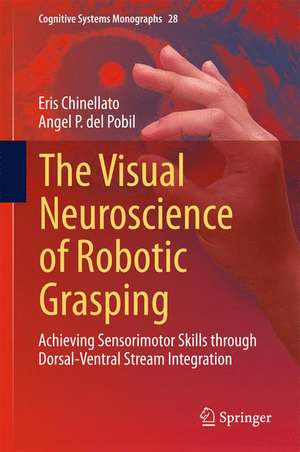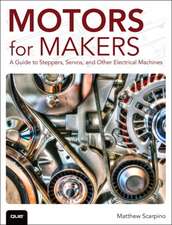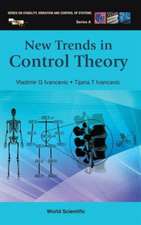The Visual Neuroscience of Robotic Grasping: Achieving Sensorimotor Skills through Dorsal-Ventral Stream Integration: Cognitive Systems Monographs, cartea 28
Autor Eris Chinellato, Angel P. del Pobilen Limba Engleză Hardback – iul 2015
Grasping in robotics is largely an unsolved problem, and we show how the bio-inspired approach is successful in dealing with some fundamental issues of the task. Our robotic system can safely perform grasping actions on different unmodeled objects, denoting especially reliable visual and visuomotor skills.
The computational model and the robotic experiments help in validating theories on the mechanisms employed by the brain areas more directly involved in grasping actions. This book offers new insights and research hypotheses regarding such mechanisms, especially for what concerns the interaction between the dorsal and ventral streams. Moreover, it helps in establishing a common research framework for neuroscientists and roboticists regarding research on brain functions.
| Toate formatele și edițiile | Preț | Express |
|---|---|---|
| Paperback (1) | 634.68 lei 6-8 săpt. | |
| Springer International Publishing – 17 oct 2016 | 634.68 lei 6-8 săpt. | |
| Hardback (1) | 640.88 lei 6-8 săpt. | |
| Springer International Publishing – iul 2015 | 640.88 lei 6-8 săpt. |
Din seria Cognitive Systems Monographs
- 15%
 Preț: 647.59 lei
Preț: 647.59 lei - 20%
 Preț: 645.31 lei
Preț: 645.31 lei - 18%
 Preț: 957.62 lei
Preț: 957.62 lei - 15%
 Preț: 632.55 lei
Preț: 632.55 lei - 15%
 Preț: 643.99 lei
Preț: 643.99 lei - 20%
 Preț: 1447.17 lei
Preț: 1447.17 lei - 15%
 Preț: 629.73 lei
Preț: 629.73 lei - 15%
 Preț: 633.02 lei
Preț: 633.02 lei - 15%
 Preț: 639.90 lei
Preț: 639.90 lei - 20%
 Preț: 643.50 lei
Preț: 643.50 lei - 15%
 Preț: 640.55 lei
Preț: 640.55 lei - 15%
 Preț: 641.71 lei
Preț: 641.71 lei - 5%
 Preț: 1103.75 lei
Preț: 1103.75 lei - 15%
 Preț: 637.59 lei
Preț: 637.59 lei - 15%
 Preț: 648.24 lei
Preț: 648.24 lei - 20%
 Preț: 650.40 lei
Preț: 650.40 lei -
 Preț: 391.02 lei
Preț: 391.02 lei - 15%
 Preț: 643.48 lei
Preț: 643.48 lei - 20%
 Preț: 663.61 lei
Preț: 663.61 lei - 20%
 Preț: 652.54 lei
Preț: 652.54 lei - 20%
 Preț: 699.43 lei
Preț: 699.43 lei - 20%
 Preț: 657.67 lei
Preț: 657.67 lei - 20%
 Preț: 1000.04 lei
Preț: 1000.04 lei - 20%
 Preț: 648.44 lei
Preț: 648.44 lei - 18%
 Preț: 886.92 lei
Preț: 886.92 lei - 20%
 Preț: 647.61 lei
Preț: 647.61 lei - 20%
 Preț: 651.09 lei
Preț: 651.09 lei - 20%
 Preț: 1161.71 lei
Preț: 1161.71 lei - 15%
 Preț: 642.68 lei
Preț: 642.68 lei - 20%
 Preț: 649.93 lei
Preț: 649.93 lei - 18%
 Preț: 944.19 lei
Preț: 944.19 lei
Preț: 640.88 lei
Preț vechi: 753.97 lei
-15% Nou
Puncte Express: 961
Preț estimativ în valută:
122.63€ • 128.05$ • 101.26£
122.63€ • 128.05$ • 101.26£
Carte tipărită la comandă
Livrare economică 15-29 aprilie
Preluare comenzi: 021 569.72.76
Specificații
ISBN-13: 9783319203027
ISBN-10: 3319203029
Pagini: 170
Ilustrații: XIII, 165 p. 56 illus., 30 illus. in color.
Dimensiuni: 155 x 235 x 17 mm
Greutate: 0.43 kg
Ediția:2016
Editura: Springer International Publishing
Colecția Springer
Seria Cognitive Systems Monographs
Locul publicării:Cham, Switzerland
ISBN-10: 3319203029
Pagini: 170
Ilustrații: XIII, 165 p. 56 illus., 30 illus. in color.
Dimensiuni: 155 x 235 x 17 mm
Greutate: 0.43 kg
Ediția:2016
Editura: Springer International Publishing
Colecția Springer
Seria Cognitive Systems Monographs
Locul publicării:Cham, Switzerland
Public țintă
ResearchCuprins
Introduction.- The Neuroscience of Action and Perception.- Intelligent Robotic Grasping?.- Vision-Based Grasping, where Robotics Meets Neuroscience.- Extraction of Grasp-Related Visual Features.- Visuomotor Transformations for Grasp Planning and Execution.- An Ever-Developing Research Framework.
Textul de pe ultima copertă
This book presents interdisciplinary research that pursues the mutual enrichment of neuroscience and robotics. Building on experimental work, and on the wealth of literature regarding the two cortical pathways of visual processing - the dorsal and ventral streams - we define and implement, computationally and on a real robot, a functional model of the brain areas involved in vision-based grasping actions.
Grasping in robotics is largely an unsolved problem, and we show how the bio-inspired approach is successful in dealing with some fundamental issues of the task. Our robotic system can safely perform grasping actions on different unmodeled objects, denoting especially reliable visual and visuomotor skills.
The computational model and the robotic experiments help in validating theories on the mechanisms employed by the brain areas more directly involved in grasping actions. This book offers new insights and research hypotheses regarding such mechanisms, especially for what concerns the interaction between the dorsal and ventral streams. Moreover, it helps in establishing a common research framework for neuroscientists and roboticists regarding research on brain functions.
Grasping in robotics is largely an unsolved problem, and we show how the bio-inspired approach is successful in dealing with some fundamental issues of the task. Our robotic system can safely perform grasping actions on different unmodeled objects, denoting especially reliable visual and visuomotor skills.
The computational model and the robotic experiments help in validating theories on the mechanisms employed by the brain areas more directly involved in grasping actions. This book offers new insights and research hypotheses regarding such mechanisms, especially for what concerns the interaction between the dorsal and ventral streams. Moreover, it helps in establishing a common research framework for neuroscientists and roboticists regarding research on brain functions.
Caracteristici
State of the art robotics and neuroscience research A novel point of view on the two visual streams theory, based on both theoretical and practical considerations, including robot implementations of computational models An insightful read both for life scientists and engineers Includes supplementary material: sn.pub/extras











